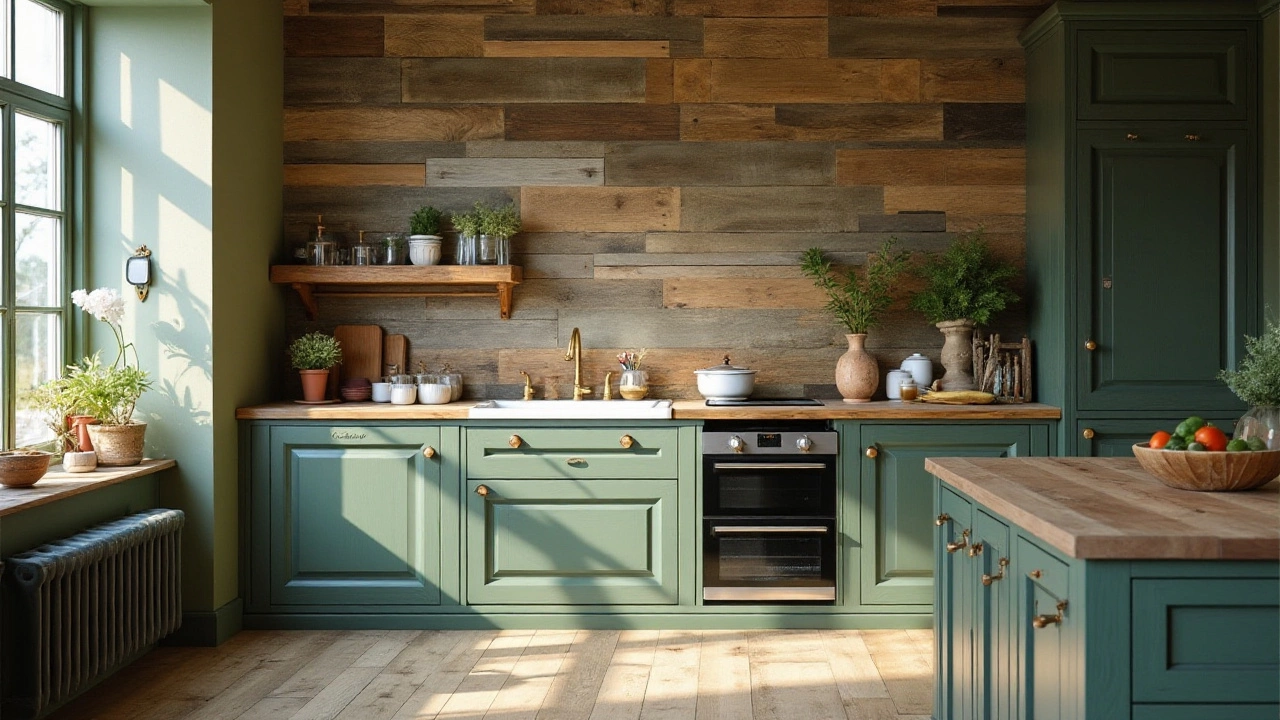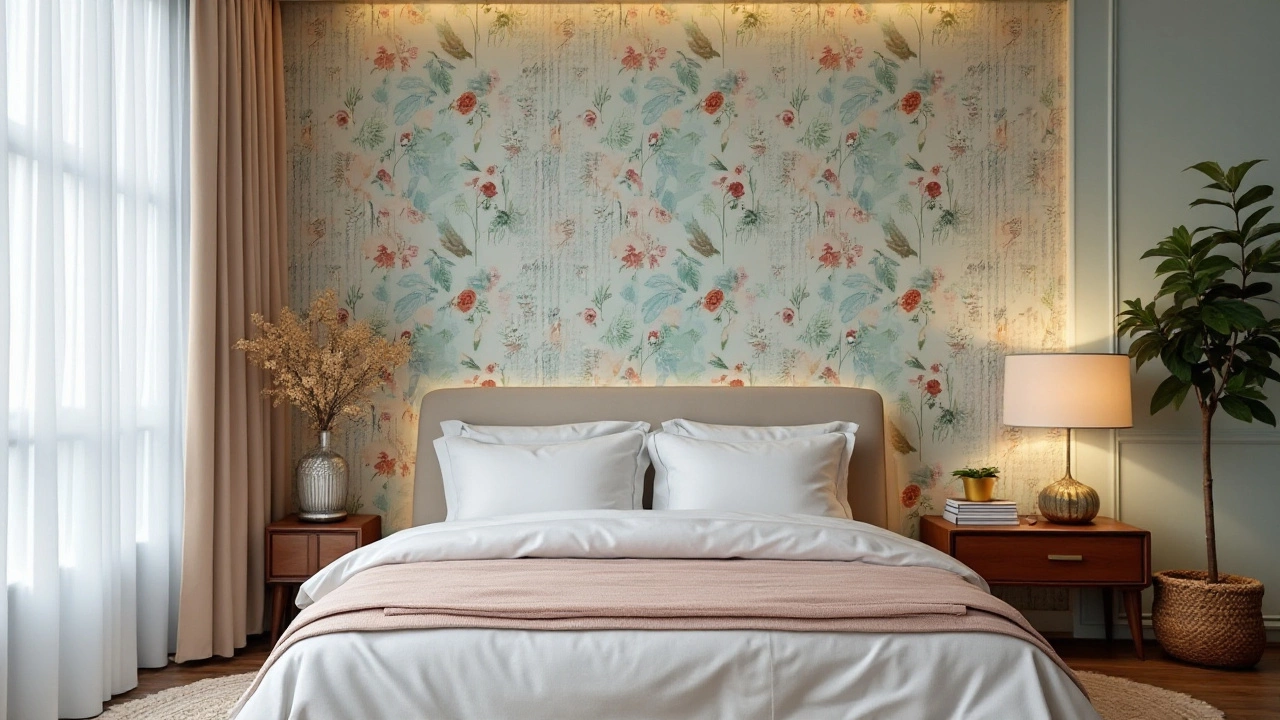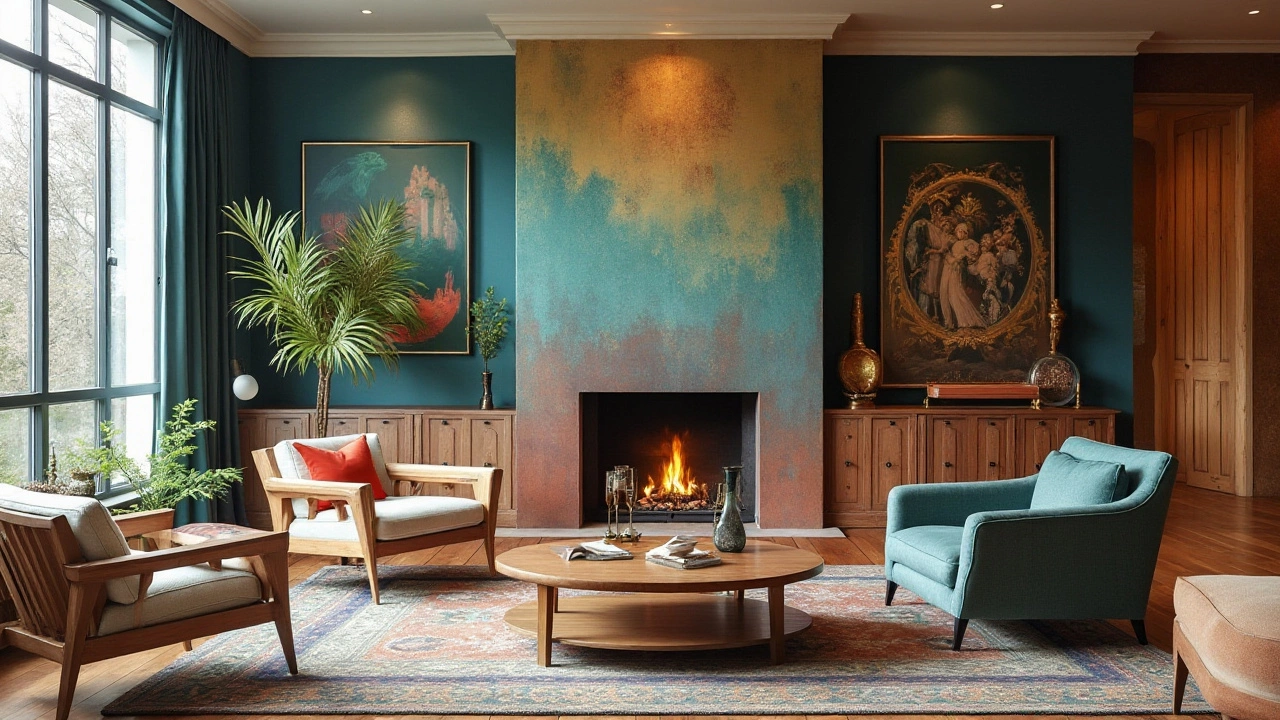As we navigate the dynamic world of interior design in 2024, one question persists: Are accent walls still en vogue? These colorful statements, once the go-to move for injecting personality into a space, have seen swings in popularity over the years. Yet, they continue to hold a special place in the hearts of those who value a touch of drama or whimsy in their abodes.
In fact, the way we approach accent walls now is much more nuanced. The concept has evolved, embracing a myriad of textures, materials, and hues that would have been unthinkable a few decades ago. From bold shades to subtle tones, today’s accent walls are as diverse as the homes they adorn.
This year, designers are focusing on how these walls can serve not only aesthetic purposes but also reflect an individual's unique style and values, like sustainability. For those debating whether to embark down the accent wall path, there’s a world of possibilities waiting just beneath the paintbrush or wallpaper. Exploring these options can lead to inspired and unexpected results in your living spaces.
- The Evolution of Accent Walls
- Current Trends and Textures
- Color Palette Choices
- Integrating Sustainability
- Tips for Effective Accent Wall Design
The Evolution of Accent Walls
The story of accent walls is rich and textured, much like the feature itself. Originating from a desire to break away from monotonous, single-hued rooms, accent walls have changed dramatically over the years. Initially, they were simple affairs—a splash of vibrant color amidst a sea of neutrals. This concept caught on rapidly during the late 20th century as more households embraced this effortless yet effective means of interior transformation. It was like adding a punctuation mark in the structure of a home, aiming for a particular stand-out factor without overhauling the entire space.
As we moved into the 21st century, the idea evolved further. People began experimenting not only with colors but with textures and patterns too. The advent of innovative paint techniques and wallpaper designs saw accent walls becoming canvases of expression. In fact, the influence of global design aesthetics brought an eclectic mix to the fore. Suddenly, your accent wall could be a gritty, industrial concrete finish or a section paved with intricate Turkish tiles. Designers like Kelly Wearstler started utilizing accent walls as focal points that embodied an entire room's theme, paving the way for more experimentation.
By the time the 2010s rolled in, accent walls faced a brief downturn as minimalism took hold with its white or grey palettes dominating interiors. Yet, they held on to their charm, especially among those who craved a bit of traditional artistry blended with contemporary designs. The trend came back with a vengeance towards the late 2010s and early 2020s. Our love for customization in home decor meant revisiting these walls with fresh ideas and techniques. Current shifts towards sustainability have only added another dimension to this beloved feature. Many now opt for materials like reclaimed wood or eco-friendly paints to create a statement that is not just artistic but responsible too.
"Accent walls are the exclamation point in a room that mirrors your personality," says interior design expert Breegan Jane, emphasizing their role in personalized space curation.
The evolution continues as today's homeowners and designers fully embrace the emotional and psychological influence of color and texture in interiors. With technology enhancing our choices—from digital customization to online visualization tools—the future indeed holds endless possibilities for accent walls. The journey of this interior design staple reflects our changing tastes, cultural influences, and an increasing awareness of both style and sustainability in home design.
Color, Pattern, and Texture: A New Era
As we look forward to the coming years, accent walls are leaning towards more intricate patterns and diverse materials. This affinity for complexity is driven by a desire to reflect nature, art, and personal stories within our living spaces. As technology allows for innovative applications, expect an even broader spectrum of possibilities that blend traditional sensibilities with cutting-edge design.Current Trends and Textures
Accent walls have undergone a fascinating transformation over the years, especially as we delve deeper into 2024. The traditional single-color wall no longer dominates the scene. Instead, a myriad infusion of textures and patterns are stealing the spotlight. In today’s modern decor, incorporating accent walls isn't just about paint; it's about creating an immersive, tactile experience. Textures like shiplap, reclaimed wood, and even velvet are being integrated to add depth and intrigue. These materials bring a fresh dimension, while simultaneously echoing the growing trend toward nature-inspired interiors.
For homeowners and designers alike, there's a distinct shift towards embracing bold and expressive textures. This year, geometric patterns and three-dimensional designs are making significant waves. These elements can transform a dull, empty wall into a captivating focal point. With a little creativity and an eye for design, these trends lend themselves to a personal expression of style. A 2024 home trend emphasizes harmony between unique textures and the overall decor, ensuring each piece feels intentional and cohesive. Such designs create a perfect marriage between contemporary aesthetics and time-honored natural touches.
The color landscape, when combined with texture, adds an additional layer to the narrative. For example, incorporating tones of rich earth alongside mixed textiles creates an atmosphere that's both calming and invigorating. Experts have observed that accent walls are favoring tones that suggest tranquility, like soft greens and blues, influenced by biophilic design principles. This trend isn't just about liking these colors but understanding how they contribute to an overall sense of well-being at home.
Interestingly, the psychology of color appears more relevant than ever. This year's palettes often draw on emotional and sensory connections with hues, promoting a balance of mood and environment. This connection is an influential factor considering how we interact with our spaces; it taps into a deeper understanding of why certain shades and textures make us feel at home. A renowned interior designer recently noted,
"In a world saturated with digital screens, it's heartening to see texture making a comeback, providing warmth and grounding spaces like never before."
Innovation is sparking fresh ideas, with textured walls becoming canvases for artistic expression. This movement is not just about visual stimuli but also plays into the acoustic qualities of a room. Textured surfaces can help absorb sound and minimize echoes, an unexpected yet delightful bonus in bustling households. This functionality, coupled with aesthetic appeal, cements textured walls as a practical choice for modern living.
As digital communities and DIY platforms grow, more individuals are exploring personal creations using unconventional materials. From intricate tile layouts to wall cladding made of bottle corks, the DIY community is embracing these trends with open arms. This hands-on approach fosters sustainability by inspiring the reuse and repurposing of materials, aligning with a growing global consciousness about environmental responsibility. The appeal of texture lies in its potential to invigorate spaces effortlessly, whether through grand or subtle means.

Color Palette Choices
When it comes to choosing a color palette for your accent walls in 2024, the options are as varied as they are exciting. The modern homeowner is no longer constrained by the muted shades of yesterday. Instead, there is a wonderful spectrum of colors that breathe life and personality into interior spaces. This year, design experts are noticing a significant shift towards hues that evoke warmth and connectivity, such as rich terracotta, earthy greens, and deep ocean blues. These colors not only enhance the ambiance of your living space but also make a bold statement about your individual style.
Integrating colors that reflect nature has become a prominent trend. This approach offers a soothing effect while inviting the outdoors into your home. Consider incorporating lush greens or rustic browns that echo the serenity found in nature. As people become more environmentally conscious, such designs resonate with those pursuing sustainable lifestyles, creating spaces that are as green as they are gorgeous. For adventurous souls, vivid colors such as sunflower yellow or electric indigo can invigorate an otherwise monochrome scheme, fostering an environment filled with energy and creativity.
Interestingly, the influence of cultural and historical references on color choices is becoming more prevalent. Homeowners are increasingly drawing inspiration from global design traditions. This might mean envisioning the exotic hues of a Moroccan bazaar or the minimalist elegance of Scandinavian designs. Such aesthetic choices allow the accent wall to function as a narrative canvas, echoing personal journeys and worldly experiences.
"A well-chosen color speaks the mood and character of the room," says Emma Roberts of the Color Institute, emphasizing the importance of thoughtful selection.
To make these color decisions accessible, here's a practical tip: always start with a color wheel. Understanding complementary colors can guide you towards choices that pleasantly contrast or harmonize with existing elements in the room. Designers suggest employing shades within the same color family for a cohesive look or using color theory to create a dynamic environment. It’s fascinating how a simple shift in tone—a slightly warmer shade of gray, for instance—can transform the entire perception of space.
If you're indecisive, testing out different color options with removable panels or temporary wallpaper can be a game-changer. This gives you the flexibility to experiment without committing, ensuring that your walls not only complement your furniture but also reflect your evolving tastes. Introducing metallic elements or using techniques like color blocking can also elevate your accent wall from ordinary to extraordinary, mesmerizing anyone who enters the room.
Lastly, keep in mind the lighting in your space will dramatically influence how these colors appear. Natural light tends to wash colors out, potentially diminishing the visual impact of lighter shades. In contrast, artificial lighting can deepen or even alter hues, particularly at night. Considering such factors when choosing your color palette can help maintain a room’s aesthetic vibrancy regardless of the time of day. So as you ponder the perfect shades for your modern decor, remember to keep your lifestyle, preferences, and environmental elements in harmonious balance, creating accent walls that inspire and delight.
Integrating Sustainability
In an era where eco-consciousness is transforming our living spaces, integrating sustainability into accent walls offers an inviting way to embrace responsible design. It's no longer just about aesthetics; the materials and methods behind these vibrant displays are equally significant. Today, many are opting for paint and materials with low or no volatile organic compounds (VOCs), which contribute to healthier indoor air quality. Brands are becoming increasingly transparent about their ecological footprint, providing consumers with options that align with their values.
One innovative approach gaining traction is the use of recycled materials. Imagine creating a striking accent wall using reclaimed wood or panels made from repurposed materials like glass or metal. These not only add character but also promote a cycle of reuse. According to the Green Building Council, incorporating such materials can significantly reduce one's environmental impact.
"Accent walls are evolving to reflect a commitment to our planet, blending style with substance to offer an enduring, meaningful statement," says interior design expert Sarah Collins.
Moreover, there's a rising trend towards using natural fibers and locally sourced materials. This approach not only supports regional artisans but also reduces the carbon footprint associated with transportation. Homeowners and designers alike are finding inspiration in their surroundings, leading to accent wall designs that are deeply personal yet globally conscious. In this realm of interior design, the mantra seems to be: think globally, act locally.
For those concerned about the longevity and lifecycle of their accent walls, there are water-based stains and treatments available that ensure wood retains its beauty without harmful pollutants. Every element, from the paintbrush to the sealer, can reflect a commitment to sustainability. By choosing thoughtfully, we create homes that nurture both our well-being and the environment.
If you are wondering how to start your sustainable accent wall project, consider sourcing your materials from certified eco-friendly suppliers. You might also want to explore marketplaces supporting sustainable practices. Many vendors are now proud to showcase their credentials, be it Forest Stewardship Council (FSC) certification or membership with recognized green initiatives. A keen eye for these details can transform a design project into a sustainable success story.

Tips for Effective Accent Wall Design
Designing an accent wall can seem daunting at first, but with a little planning and creativity, it's a project that anyone can tackle. The key is to think of the accent wall as a harmonious part of the room rather than a standalone masterpiece. Start by choosing a wall that naturally draws attention or complements the room's layout. Ideal candidates are often the wall behind a headboard, the fireplace wall, or an unbroken stretch in a long hallway. This doesn’t just draw the eye, but it can also accentuate architectural features already present in your home.
The next step involves picking a theme or overall vibe for the room. Some people prefer bold, dramatic colors, while others lean toward neutral palettes with textural elements like reclaimed wood or brick. Either choice can be stunning when executed properly. To get it right, gather samples and pin them to the wall, see how they interact with varying light conditions throughout the day. Natural light can dramatically shift the perception of color, as can artificial lighting commonly found in homes.
Among the modern trends, artisans are exploring unique patterns and textures for accent walls. A prominent designer, Kelly Wearstler, once said,
"The best rooms have something to say about the people who live in them."So consider incorporating materials that have personal significance or tie into your home's overarching design scheme. Use wood paneling for a warm, rustic look, or perhaps metallic tiles for a sophisticated, modern appeal. Don't shy away from incorporating art or decorative elements directly onto the wall that blend seamlessly with the design yet stand out just enough to make a statement.
When it comes to colors, some of the most popular shades this year include deep forest greens, ochre, and cool blues. These shades work exceptionally well in creating an emotional response. Consider the psychological impact when painting a room with a hue intended to evoke feelings of relaxation or energy. Also, remember that paint finish matters too. Matte finishes might give a more muted, elegant look, while semi-gloss or gloss can help bounce light around smaller or darker rooms.
Sustainability is taking center stage in 2024. Many homeowners are opting for eco-friendly paints and materials for their home interiors. Low-VOC or no-VOC paints are safer for indoor air quality and better for the environment. Upcycle wood or metal to add a unique touch without contributing to waste. Reclaimed wood, in particular, is both a popular and conscientious choice. A growing number of companies provide materials with rich histories, adding depth, character, and a perfect conversation starter to any room.
Now, think about how the accent wall will unify the room's decor. This might involve carrying the wall color into other parts of the room, such as on throw pillows, rugs, or artwork. This repetition creates cohesion, making the accent feature look like an intentional part of a broader aesthetic. Be sure to plan where furniture and decor pieces will sit against the wall to keep from overshadowing or cluttering the highlight of the room. With your own instincts and these pointers, crafting a unique space that both excites and comforts is within reach.
 EN
EN
 HR
HR
 AR
AR

